

The Boott Cotton Mills of Lowell, Massachusetts. Ike a medieval fortress or great cathedral, the structure dominates all that is around it.
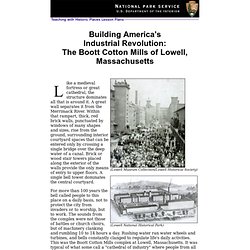
A great wall separates it from the Merrimack River. Within that rampart, thick, red brick walls, punctuated by windows of many shapes and sizes, rise from the ground, surrounding interior courtyard spaces that can be entered only by crossing a single bridge over the deep water of a canal. Brick or wood stair towers placed along the exterior of the walls provide the only means of entry to upper floors.
A single bell tower dominates the central courtyard. For more than 100 years the bell called people to this place on a daily basis, not to protect the city from invaders or to worship, but to work. Spinning down superpower: An interview with Quinn Norton - The Breaking Time. So if you can immediately find a group of people like you across the country and even the world, then why bother with where you live?

Yes, exactly. When you think about it, while there are a lot of people that would kind of poo-poo that change, but where you live is kind of an arbitrary marker [laughing]. P.T. Barnum Discovers "Tom Thumb," 1842. P.T.
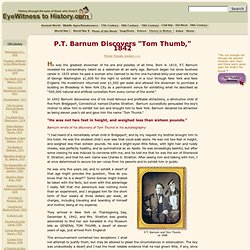
Barnum Discovers "Tom Thumb," 1842 He was the greatest showman of his era and possibly of all time. Born in 1810, P.T. Barnum revealed his extraordinary talent as a salesman at an early age. Barnum began his show business career in 1835 when he paid a woman who claimed to be the one-hundred-sixty-one-year-old nurse of George Washington $1,000 for the right to exhibit her in a tour through New York and New England. In 1842 Barnum discovered one of his most famous and profitable attractions, a diminutive child of five from Bridgeport, Connecticut named Charles Stratton. Barnum wrote of his discovery of Tom Thumb in his autobiography: "I had heard of a remarkably small child in Bridgeport; and by my request my brother brought him to the hotel. He was only five years old, and to exhibit a dwarf of that age might provoke the question, 'How do you know that he is a dwarf?
' They arrived in New York on Thanksgiving Day, December 8, 1842, and Mrs. This announcement contained two deceptions. America's First Steam Locomotive, 1830. America's First Steam Locomotive, 1830 In the 1820s the port of Baltimore was in danger.
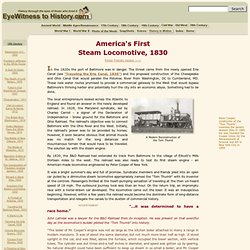
The threat came from the newly opened Erie Canal (see "Traveling the Erie Canal, 1836") and the proposed construction of the Chesapeake and Ohio Canal that would parallel the Potomac River from Washington, DC to Cumberland, MD. These new water routes promised to provide a commercial gateway to the West that would bypass Baltimore's thriving harbor and potentially hurl the city into an economic abyss. Something had to be done. The local entrepreneurs looked across the Atlantic to England and found an answer in the newly developed railroad. By 1830, the B&O Railroad had extended its track from Baltimore to the village of Ellicott's Mills thirteen miles to the west. It was a bright summer's day and full of promise. John Latrobe was a lawyer for the B&O Railroad from its inception. The Industrial Revolution. Cotton Gin. The Fiber of Slavery. King Cotton: The Fiber of Slavery By Jean M. West "It was work hard, git beatins and half fed ... .
The times I hated most was pickin' cotton when the frost was on the bolls. My hands git sore and crack open and bleed. " One of the first images of slavery that leaps into everyone's mind is the scene of slaves stooped over, picking cotton, and hauling huge cotton-stuffed bags behind them. Gossypium Although botanists are still uncertain about the origins of cotton or when humans first domesticated it and began using it, species of wild cotton grow in tropical zones in Africa, the Americas, and Australia, wherever there are long, sunny days without frost for at least 160 days. Cotton Comes to Europe Cotton was not native to Europe; however, early Greeks, for instance the historian Herodotus, struggled to describe cotton, explaining that it was "wild plant that bears fleece exceeding in goodness and beauty that of sheep. " The Eli Whitney Museum and Workshop. In 1798 Eli Whitney built a firearms factory near New Haven.
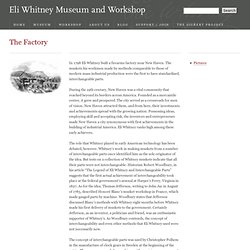
The muskets his workmen made by methods comparable to those of modern mass industrial production were the first to have standardized, interchangeable parts. During the 19th century, New Haven was a vital community that reached beyond its borders across America. Founded as a mercantile center, it grew and prospered. Transcontinental Railroad. Fulton's First Steamboat Voyage, 1807. Fulton's First Steamboat Voyage, 1807 Painter, inventor and engineer, Robert Fulton was a man of many talents.
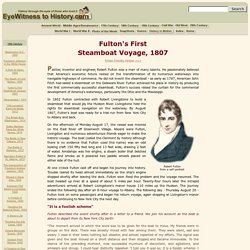
He passionately believed that America's economic future rested on the transformation of its numerous waterways into navigable highways of commerce. He did not invent the steamboat - as early as 1787, American John Fitch had sailed a steamboat on the Delaware River. Fulton achieved his place in history by producing the first commercially successful steamboat. In 1802 Fulton contracted with Robert Livingstone to build a steamboat that would ply the Hudson River.